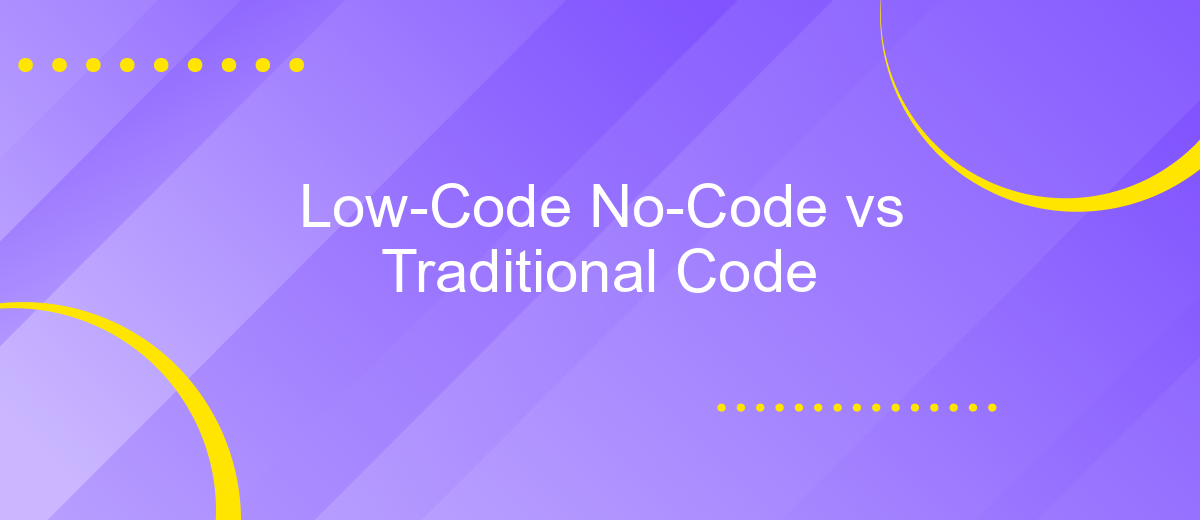Low-Code No-Code vs Traditional Code
In today's fast-paced digital landscape, the debate between Low-Code/No-Code platforms and traditional coding methods is more relevant than ever. Businesses and developers are constantly seeking efficient ways to build and deploy applications. This article explores the key differences, advantages, and limitations of Low-Code/No-Code solutions compared to traditional coding, helping you make an informed decision for your next project.
Introduction
In today's rapidly evolving technological landscape, businesses are constantly seeking efficient ways to develop and deploy software applications. One of the most significant debates in this realm is the comparison between Low-Code/No-Code platforms and traditional coding methods. Each approach offers unique advantages and challenges, making it crucial for organizations to understand their differences and applications.
- Low-Code/No-Code Platforms: These platforms enable users to create applications with minimal or no coding knowledge, using visual interfaces and pre-built components.
- Traditional Coding: This method involves writing code manually, offering greater flexibility and control but requiring extensive programming knowledge and time.
While Low-Code/No-Code platforms like ApiX-Drive simplify the integration of various services and automate workflows without deep technical expertise, traditional coding remains indispensable for complex, highly customized solutions. Understanding when to leverage each approach can significantly impact a business's agility, innovation, and overall success in the digital age.
Low-Code No-Code Overview

Low-Code and No-Code platforms are revolutionizing the way applications are developed by enabling users to create software solutions with minimal or no coding skills. These platforms provide visual interfaces, pre-built templates, and drag-and-drop functionalities, making it easier for non-developers to build and deploy applications quickly. This democratization of software development allows businesses to accelerate their digital transformation efforts and reduce dependency on traditional coding experts.
One of the significant advantages of Low-Code and No-Code platforms is their ability to streamline integrations with various services and APIs. For example, ApiX-Drive is a tool that simplifies the process of connecting different applications and automating workflows without requiring extensive coding knowledge. By leveraging such services, users can easily integrate their Low-Code or No-Code applications with other systems, enhancing their functionality and ensuring seamless data flow across platforms. This not only saves time but also reduces the complexity typically associated with traditional coding methods.
Traditional Code Overview

Traditional coding involves the use of programming languages such as Python, Java, and C++ to create software applications. This method requires a deep understanding of coding principles, algorithms, and data structures. Developers write and maintain code manually, which allows for high levels of customization and optimization but also demands significant time and expertise.
- Customizability: Traditional coding offers unparalleled flexibility, enabling developers to create highly specialized solutions tailored to specific needs.
- Performance: Hand-written code can be optimized for performance, making it ideal for resource-intensive applications.
- Integration: Traditional code allows for complex integrations with various services and APIs. For example, developers can use ApiX-Drive to streamline the integration process, connecting multiple applications seamlessly.
- Scalability: Well-written traditional code can scale efficiently to handle growing user bases and increasing data loads.
Despite its advantages, traditional coding can be time-consuming and requires a high level of expertise. It demands continuous learning and adaptation to new technologies and standards. However, for projects that require extensive customization and high performance, traditional coding remains an indispensable approach.
Low-Code No-Code vs Traditional Code: Key Differences

Low-Code and No-Code platforms offer a streamlined approach to software development, enabling users with minimal coding skills to create applications. These platforms provide pre-built templates and drag-and-drop functionalities, making the development process faster and more accessible. On the other hand, traditional coding requires a deep understanding of programming languages and extensive development time.
One of the major differences between these approaches is flexibility. Traditional coding allows for complete customization and control over the application, while Low-Code and No-Code platforms might have limitations in terms of complex functionalities. This can be a significant consideration for businesses with specific, intricate requirements.
- Development Speed: Low-Code/No-Code is faster, traditional coding is slower but more thorough.
- Customization: Traditional coding offers full customization, Low-Code/No-Code has limitations.
- Skill Requirement: Low-Code/No-Code requires minimal coding skills, traditional coding requires advanced skills.
- Integration: Low-Code/No-Code platforms often come with built-in integrations, such as ApiX-Drive for seamless connectivity.
Ultimately, the choice between Low-Code/No-Code and traditional coding depends on the specific needs and resources of the project. For rapid development and simpler applications, Low-Code/No-Code is ideal. However, for highly customized and complex solutions, traditional coding remains the best option.
Conclusion
In conclusion, the debate between Low-Code/No-Code platforms and traditional coding approaches hinges on the specific needs and goals of a project. Low-Code/No-Code platforms offer rapid development, lower costs, and accessibility for non-developers, making them ideal for businesses looking to quickly implement solutions without extensive technical expertise. However, they may lack the flexibility and scalability required for more complex or highly customized applications, where traditional coding stands out due to its robustness and adaptability.
Ultimately, the choice between these two approaches should be guided by the project’s complexity, required customization, and available resources. Tools like ApiX-Drive can further enhance the efficiency of Low-Code/No-Code platforms by simplifying integrations and automating workflows, bridging the gap between ease of use and functional depth. By leveraging the strengths of both methodologies, businesses can optimize their development processes, ensuring that they meet their specific needs effectively and efficiently.
FAQ
What is the main difference between Low-Code/No-Code and Traditional Coding?
Who should use Low-Code/No-Code platforms?
Can Low-Code/No-Code platforms handle complex applications?
How do Low-Code/No-Code platforms integrate with existing systems?
Are Low-Code/No-Code platforms secure?
Routine tasks take a lot of time from employees? Do they burn out, do not have enough working day for the main duties and important things? Do you understand that the only way out of this situation in modern realities is automation? Try Apix-Drive for free and make sure that the online connector in 5 minutes of setting up integration will remove a significant part of the routine from your life and free up time for you and your employees.

